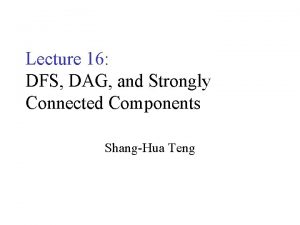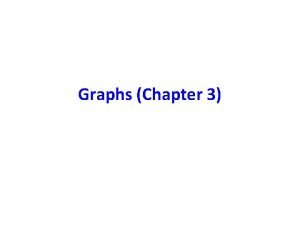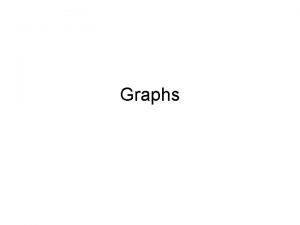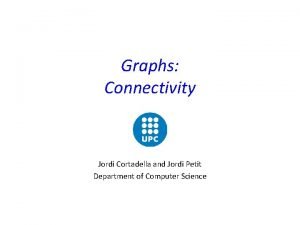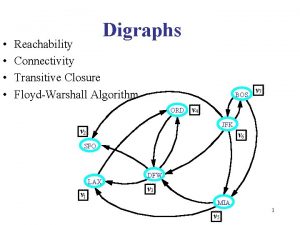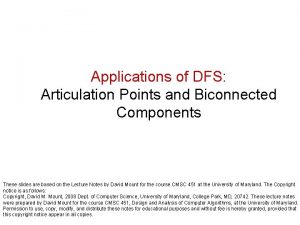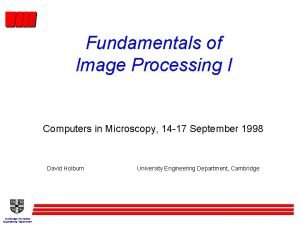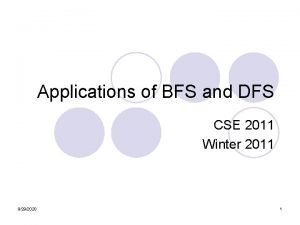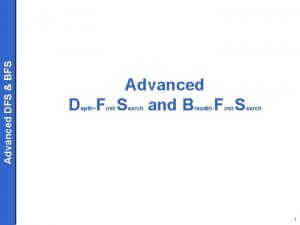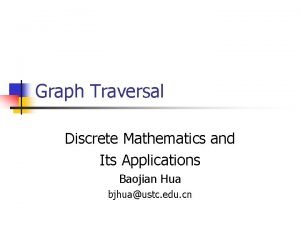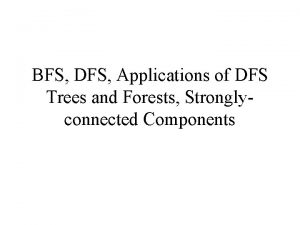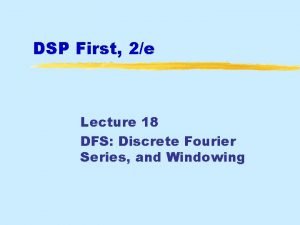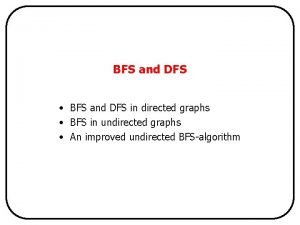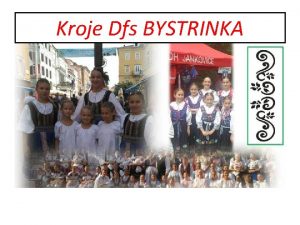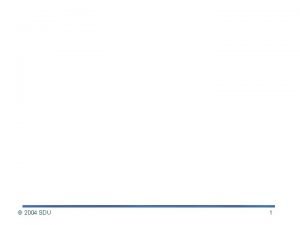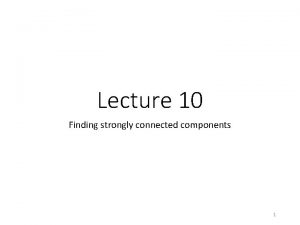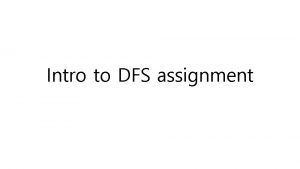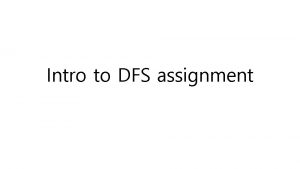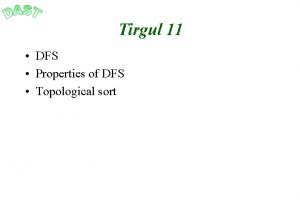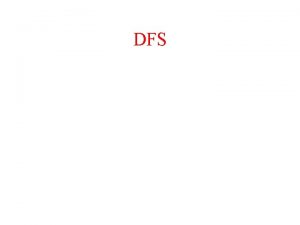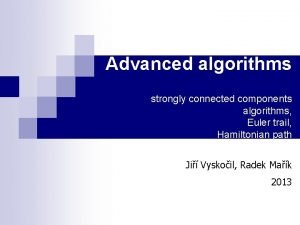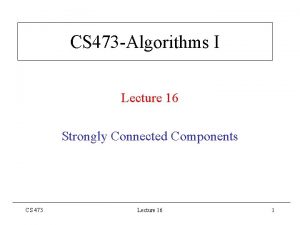Lecture 16 DFS DAG and Strongly Connected Components




![A Topological Sort Algorithm Topological-Sort() { 1. Call DFS to compute finish time f[v] A Topological Sort Algorithm Topological-Sort() { 1. Call DFS to compute finish time f[v]](https://slidetodoc.com/presentation_image/5ad50ea85729b9c29dd8c12cecb8961b/image-5.jpg)
![Correctness of Topological Sort • Lemma: (u, v) G f[u] > f[v] – When Correctness of Topological Sort • Lemma: (u, v) G f[u] > f[v] – When](https://slidetodoc.com/presentation_image/5ad50ea85729b9c29dd8c12cecb8961b/image-6.jpg)













![Strongly-Connected Components Strongly-Connected-Components(G) 1. call DFS(G) to compute finishing times f[u] for each vertex Strongly-Connected Components Strongly-Connected-Components(G) 1. call DFS(G) to compute finishing times f[u] for each vertex](https://slidetodoc.com/presentation_image/5ad50ea85729b9c29dd8c12cecb8961b/image-20.jpg)






- Slides: 26

Lecture 16: DFS, DAG, and Strongly Connected Components Shang-Hua Teng

Directed Acyclic Graphs • A directed acyclic graph or DAG is a directed graph with no directed cycles:

DFS and DAGs • Theorem: a directed graph G is acyclic iff a DFS of G yields no back edges: – => if G is acyclic, will be no back edges • Trivial: a back edge implies a cycle – <= if no back edges, G is acyclic • Proof by contradiction: G has a cycle a back edge – Let v be the vertex on the cycle first discovered, and u be the predecessor of v on the cycle – When v discovered, whole cycle is white – Must visit everything reachable from v before returning from DFS-Visit() – So path from u v is gray, thus (u, v) is a back edge

Topological Sort • Topological sort of a DAG: – Linear ordering of all vertices in graph G such that vertex u comes before vertex v if edge (u, v) G • Real-world application: Scheduling a dependent graph, find a feasible course plan for university studies
![A Topological Sort Algorithm TopologicalSort 1 Call DFS to compute finish time fv A Topological Sort Algorithm Topological-Sort() { 1. Call DFS to compute finish time f[v]](https://slidetodoc.com/presentation_image/5ad50ea85729b9c29dd8c12cecb8961b/image-5.jpg)
A Topological Sort Algorithm Topological-Sort() { 1. Call DFS to compute finish time f[v] for each vertex 2. As each vertex is finished, insert it onto the front of a linked list 3. Return the linked list of vertices } • Time: O(V+E) • Correctness: need to prove that (u, v) G f[u]>f[v]
![Correctness of Topological Sort Lemma u v G fu fv When Correctness of Topological Sort • Lemma: (u, v) G f[u] > f[v] – When](https://slidetodoc.com/presentation_image/5ad50ea85729b9c29dd8c12cecb8961b/image-6.jpg)
Correctness of Topological Sort • Lemma: (u, v) G f[u] > f[v] – When (u, v) is explored, u is gray, consider the following cases: 1. v is gray (u, v) is back edge. Can’t happen, if G is a DAG. 2. v if white v becomes descendent of u f[v] < f[u] (since must finish v before backtracking and finishing u) 3. v is black v already finished f[v] < f[u]

Our Algorithm for Topological Sorting is correct

Strongly Connected Directed graphs • Every pair of vertices are reachable from each other a g c d f e b

Strongly-Connected Graph G is strongly connected if, for every u and v in V, there is some path from u to v and some path from v to u. Strongly Connected Not Strongly Connected

Strongly-Connected Components A strongly connected component of a graph is a maximal subset of nodes (along with their associated edges) that is strongly connected. Nodes share a strongly connected component if they are inter-reachable.

Strongly Connected Components a g c d f e {a, c, g} {f, d, e, b} b

Reduced Component Graph of Strongly Connected Components a g c d f {a, c, g} {f, d, e, b} e b • Component graph GSCC=(VSCC, ESCC): one vertex for each component – (u, v) ESCC if there exists at least one directed edge from the corresponding components

Strongly Connected Components

Graph of Strongly Connected Components • Theorem: the Component graph GSCC=(VSCC, ESCC) is a DAG – Each component is maximal in the sense that no other vertices can be added to it. If GSCC=(VSCC, ESCC) is not a DAG, then one can merge components on along a circle of GSCC • Therefore, GSCC has a topological ordering

Finding Strongly-Connected Components • Input: A directed graph G = (V, E) • Output: a partition of V into disjoint sets so that each set defines a strongly connected component of G • How should we compute the partition?

Graph of Strongly Connected Components • Recall: Theorem: the Component graph GSCC=(VSCC, ESCC) is a DAG – Each component is maximal in the sense that no other vertices can be added to it. If GSCC=(VSCC, ESCC) is not a DAG, then one can merge components on along a circle of GSCC • Therefore, GSCC has a topological ordering

DFS on G Topological Sort GSCC=(VSCC, ESCC) • Let U be a subset of V • If we output U in VSCC in the decreasing order of f[U], then we topologically sort GSCC • Lemma: Let U and U’ be distinct strongly connected component, suppose there is an edge (u, v) in E where u in U and v in U’. Then f[U] > f[U’]

Proof of the Lemma: Let U and U’ be distinct strongly connected component, suppose there is an edge (u, v) in E where u in U and v in U’. Then f[U] > f[U’] Proof: Two cases 1. d[U] < d[U’], say x in U is the first vertex 2. d[U’] < d[U], say y is the first, but U is not reachable from y

Transpose of a Digraph Transpose of G = (V, E): GT=(V, ET), where ET={(u, v): (v, u) E} If G is a DAG then GT is also a DAG If we print the topological order of G in the reverse order, then it is a topological order of GT
![StronglyConnected Components StronglyConnectedComponentsG 1 call DFSG to compute finishing times fu for each vertex Strongly-Connected Components Strongly-Connected-Components(G) 1. call DFS(G) to compute finishing times f[u] for each vertex](https://slidetodoc.com/presentation_image/5ad50ea85729b9c29dd8c12cecb8961b/image-20.jpg)
Strongly-Connected Components Strongly-Connected-Components(G) 1. call DFS(G) to compute finishing times f[u] for each vertex u. 2. compute GT 3. call DFS(GT), but in the main loop of DFS, consider the vertices in order of decreasing f[u] 4. output the vertices of each tree in the depth-first forest of step 3 as a separate strongly connected component. The graph GT is the transpose of G, which is visualized by reversing the arrows on the digraph.

Strong Components: example a b d c a 4 d 1 b 3 c 2 Graph Gr a 4 c 2 b 3 a 4 after step 1 d 1 b 3 c 2 d 1 df spanning forest for Gr

Runtime Lines 1 and 3 are (E+V) due to DFS Line 2 involves creating an adjacency list or matrix, and it is also O(E+V) Line 4 is constant time So, SCC(G) is (E+V)

Strongly-Connected Components DFS on G, starting at c. node a d=13 f=14 node b d=11 f=16 node c d=1 f=10 node d d=8 f=9 node e d=12 f=15 node f d=3 f=4 node g d=2 f=7 node h d=5 f=6

DFS on GT node a d=13 f=14 node b d=11 f=16 node c d=1 f=10 node d d=8 f=9 node e d=12 f=15 node f d=3 f=4 node g d=2 f=7 node h d=5 f=6 node a d=2 f=5 =b node b d=1 f=6 =NIL node c d=7 f=10 =NIL node d d=8 f=9 =c node e d=3 f=4 =a node f d=12 f=13 =g node g d=11 f=14 =NIL node h d=15 f=16 =NIL

DFS on GT This is GT, labeled after running DFS(GT). In order of decreasing finishing time, process the nodes in this order: b e a c d g h f. GT : node a d=2 f=5 =b node b d=1 f=6 =NIL node c d=7 f=10 =NIL node d d=8 f=9 =c node e d=3 f=4 =a node f d=12 f=13 =g node g d=11 f=14 =NIL node h d=15 f=16 =NIL

Strongly-Connected Components These are the 4 trees that result, yielding the strongly connected components. Finally, merge the nodes of any given tree into a super-node, and draw links between them, showing the resultant acyclic component graph. b c g a d f a b c d e f g h h abe e cd fg Component Graph h
 Dfs strongly connected components
Dfs strongly connected components Strongly connected graph
Strongly connected graph Strongly connected components
Strongly connected components Tarjan algorithm complexity
Tarjan algorithm complexity Strongly connected components
Strongly connected components Jordi cortadella
Jordi cortadella Napoj otrzymano po tym jak
Napoj otrzymano po tym jak Hvilke dag er det i dag
Hvilke dag er det i dag Bi sang
Bi sang Strongly connected
Strongly connected Biconnected components and dfs
Biconnected components and dfs In a y-connected source feeding a ∆-connected load,
In a y-connected source feeding a ∆-connected load, Line currents
Line currents In a triangle connected source feeding a y connected load
In a triangle connected source feeding a y connected load 01:640:244 lecture notes - lecture 15: plat, idah, farad
01:640:244 lecture notes - lecture 15: plat, idah, farad Connected components analysis
Connected components analysis Difference between strongly and weakly typed languages
Difference between strongly and weakly typed languages Applications of dfs and bfs
Applications of dfs and bfs Dfs bfs
Dfs bfs Bfs in discrete mathematics
Bfs in discrete mathematics Applications of dfs and bfs
Applications of dfs and bfs Dfs in dsp
Dfs in dsp Solved problems on bfs and dfs
Solved problems on bfs and dfs Mildly flavored vegetables cooking methods
Mildly flavored vegetables cooking methods Strongly typed vs weakly typed
Strongly typed vs weakly typed Hawthorne effect in business
Hawthorne effect in business Latitude strongly influences climate because
Latitude strongly influences climate because
